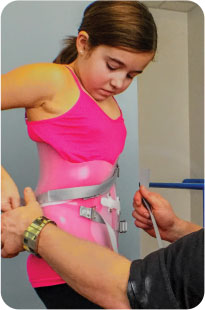
In pursuit of smaller curves
For patients with adolescent idiopathic scoliosis (AIS), the gold standard goal for full-time rigid bracing is to stop the progression of the curve during growth through the implementation of a custom 3D-Asymmetrical TLSO (Costa et al., 2021). The SOSORT guidelines recommend full-time rigid bracing (FTRB) for curve angles between 20° and 45° Cobb (Wibmer et al., 2018) .The Cobb angle is defined as the angle between the most tilted upper vertebra and the most tilted lower vertebra within the curvature of the spine (Deepak et al. 2017). At Hodgson, we have used the SOSORT guidelines to build a treatment pathway for families to give them the best chance of success as they work to redirect the curve’s progression if that is one of their goals for treatment. The question often hangs in our consultations however, “can’t my curve get better?”
Beating the odds in bracing is similar to getting an A+ on a test in school; there is no guarantee, but with the right plan and their best effort, patients within the SOSORT criteria who have growth remaining all have a chance. A study showed that patients increased their average brace wear time if doctors provide proper instructions, indicating the chance for effective Cobb angle reduction with full-time rigid-brace treatment in compliant patients (Kato et al., 2019) Although there is high quality evidence such as this meta analysis by (Marsim et al., 2023) showing that the gold standard can be beaten; more research will be required before the SOSORT standards will shift & what is now gold will become silver.
Platinum Club status is awarded to those who have taken the challenge and beaten the gold standard. They are brave and committed, the results show that they stood tall and exceeded the expectations. The Platinum Club series will highlight success in the exploration of why some exceed expectations and some do not. We hope to learn from our efforts and analysis. Trends will emerge so future patients may be empowered through this new understanding and treatment transparency. We at Hodgson want those with AIS to know that better is possible and a brace can do so much more than just keep things from getting worse.
- Costa, L., Schlösser, T. P. C., Jimale, H., Homans, J. F., Kruyt, M. C., & Castelein, R. M. (2021). The effectiveness of different concepts of bracing in adolescent idiopathic scoliosis (ais): a systematic review and meta-analysis. Journal of Clinical Medicine, 10(10), 2145. https://doi.org/10.3390/jcm10102145
- Deepak, A. S., Ong, J. Y., Choon, D., Chiu, C. K., Chan, C. Y. W., & Kwan, M. K. (2017). The clinical effectiveness of school screening programme for idiopathic scoliosis in malaysia. Malaysian Orthopaedic Journal, 11(1), 41-46. https://doi.org/10.5704/moj.1703.018
- Kato, T., Inose, H., Ichimura, S., Tokuhashi, Y., Nakamura, H., Hoshino, M., … & Okawa, A. (2019). Comparison of rigid and soft-brace treatments for acute osteoporotic vertebral compression fracture: a prospective, randomized, multicenter study. Journal of Clinical Medicine, 8(2), 198. https://doi.org/10.3390/jcm8020198
- Wibmer, C., Trotsenko, P., Gilg, M., Leithner, A., & Sperl, M. (2018). Observational retrospective study on socio-economic and quality of life outcomes in 41 patients with adolescent idiopathic scoliosis 5 years after bracing combined with physiotherapeutic scoliosis-specific exercises (psse). European Spine Journal, 28(3), 611-618. https://doi.org/10.1007/s00586-018-5746-2
Platinum Club Case Studies
Successful Bracing Treatment for Adolescent Idiopathic Scoliosis with 3D Asymmetrical Bracing




